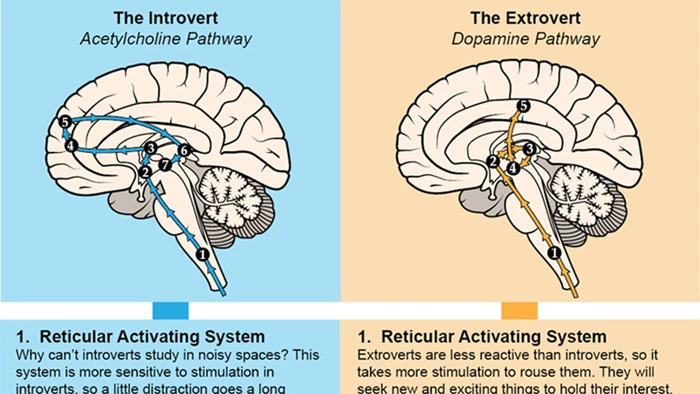Developing an introvert’s superpower
Do you know someone who can absorb a vast amount of complex information about a problem and combine it into a cohesive, elegant solution?
Developing an introvert’s superpower
An introvert is uniquely suited to develop this superpower; solving problems with multiple interrelated constraints.

Why is an introvert’s brain wired to solve these problems? This infographic by Kyle Rohane excellently describes how an introverts’ brain behaves differently than an extroverts’ brain: “The anterior thalamus acts as a relay station, sending signals to the anterior cingulated gyrus and frontal lobe, which help introverts recall events or imagine new possibilities. With a little time, introverts can come up with creative solutions to problems through imaginative trial and error.”
The word “introvert” has a negative connotation in today’s society, but this notion is being turned on its head by recent research and books like “Quiet: The Power of Introverts in a World That Can’t Stop Talking” by Susan Cain.
In the arena of product design, there is typically a point early in the project where multiple solutions to each individual problem must be brainstormed and combined into a cohesive whole. Each solution needs to be matched up in a way that works together. In the field of mechanical engineering product design, this is typically called a configuration concept. It’s depicted by a holistic sketch or cross section of the product where the part breakup, moldability, assembly, component layout, airflow, wire routing, etc., have been solved. This also applies to any task that involves multiple interrelated problems that must be solved simultaneously (for example, experience maps, process flows, or electrical schematics).
Introverts’ brain pathways favor the thinking mode where several solutions to individual problems are played out in their mind simultaneously. Any compromises or interactions between those ideas are evaluated, resulting in a configuration concept where all the pieces of the puzzle work together.
If you’re an introvert, I’d propose following this process to harness your superpower and develop your potential for idea generation.
Step 1: Gathering information
- Take a close look at the type of problem you are trying to solve. Are the problems truly interrelated or can they be solved individually? If each component of the problem can be solved independently of the others, then it can be solved by a wide variety of standard brainstorming techniques and this article doesn’t apply.
- Gather all the data, pictures, puzzle pieces and constraints.
- Ask any initial questions and sketch out initial ideas.
- Write everything down by hand and post it on a wall. It’s tempting to skip this step, but I have found that step 2 will be ineffective if the information isn’t drilled deep enough into the subconscious through these activities. Seeing all of the problems that need to be solved simultaneously is important to engage the visual parts of the brain. Handwriting engages more of the brain and burns information deeper into memory than typing.
Step 2: Let your brain marinate in the information overnight.
- The brain requires soak time because ideas spring forth during the lucid thought processes that happen at night.
- Creative people throughout history have known about this technique. For example, Thomas Edison believed napping was critical to his best ideation.
- Step 3: Capture and critique your ideas. Question the constraints.
- Spend quiet time in the morning sketching any ideas from the night before.
- Evaluate your ideas. The conscious thought processes that happen during the day are naturally more logical and critical. Filtering through your ideas solo emotionally prepares you for evaluating them with other people.
- Invite someone to critique your ideas, but be careful. It’s natural to get emotionally invested in our ideas and to feel some sense of rejection when someone else doesn’t like them. Unfortunately, the hippocampus tags this experience as “personal.” This gets in the way of productive brainstorming. Try to stop that thought as quickly as possible and move on to the next concept. In time, your brain will spend less and less time in the emotional state, leaving more time for evaluating ideas.
- Challenge the constraints of the problem and be bold enough to ask “why” five times to dig into the root of the constraint.
Step 4: Allow the problem to soak for one more night.
- At this point, your brain is wrapped around the constraints and the possible solutions and able to subconsciously filter through the solutions that won’t work.
- This is a numbers game. As the brain considers more possibilities and filters through more solutions, the final holistic solution will become more refined.
Step 5: Documenting the solutions
- You should have a few holistic solutions that can then be sketched out in detail. As your visualization and sketching skills become more developed, you won’t need to put your creative process on hold for a moment while you sketch. Then, sketching and ideation can happen simultaneously.
- Share, critique and evaluate your ideas with stakeholders.
You’re probably thinking “Three days! That sounds like it takes forever. I need an answer now.” It does take a long time, but consider the time wasted with a partial solution that only addresses some aspects of the problem. Have you ever run a meeting to solve a complex problem with interrelated issues and left with a handful of ideas that solve some aspects but not all of them?
If you have a problem that requires interrelated problems to be solved simultaneously, then this might be the fastest way to a solution. Attempting to solve these types of problems with a series of group brainstorming sessions typically results in partial solutions. The project manager hopes that these can be conveniently merged together at the end without creating any compromises to the holistic solution. How is that working for you?
In a future blog post, I’ll discuss ways to speed up the process by deepening your self-awareness of whether you are in a creative brainstorming mode or in the critical evaluating mode. The faster you can switch back and forth between those two modes, and the more you can push yourself to break away from your preconceived solutions to the problem, the faster you can arrive at an elegant solution that solves all the problems.
